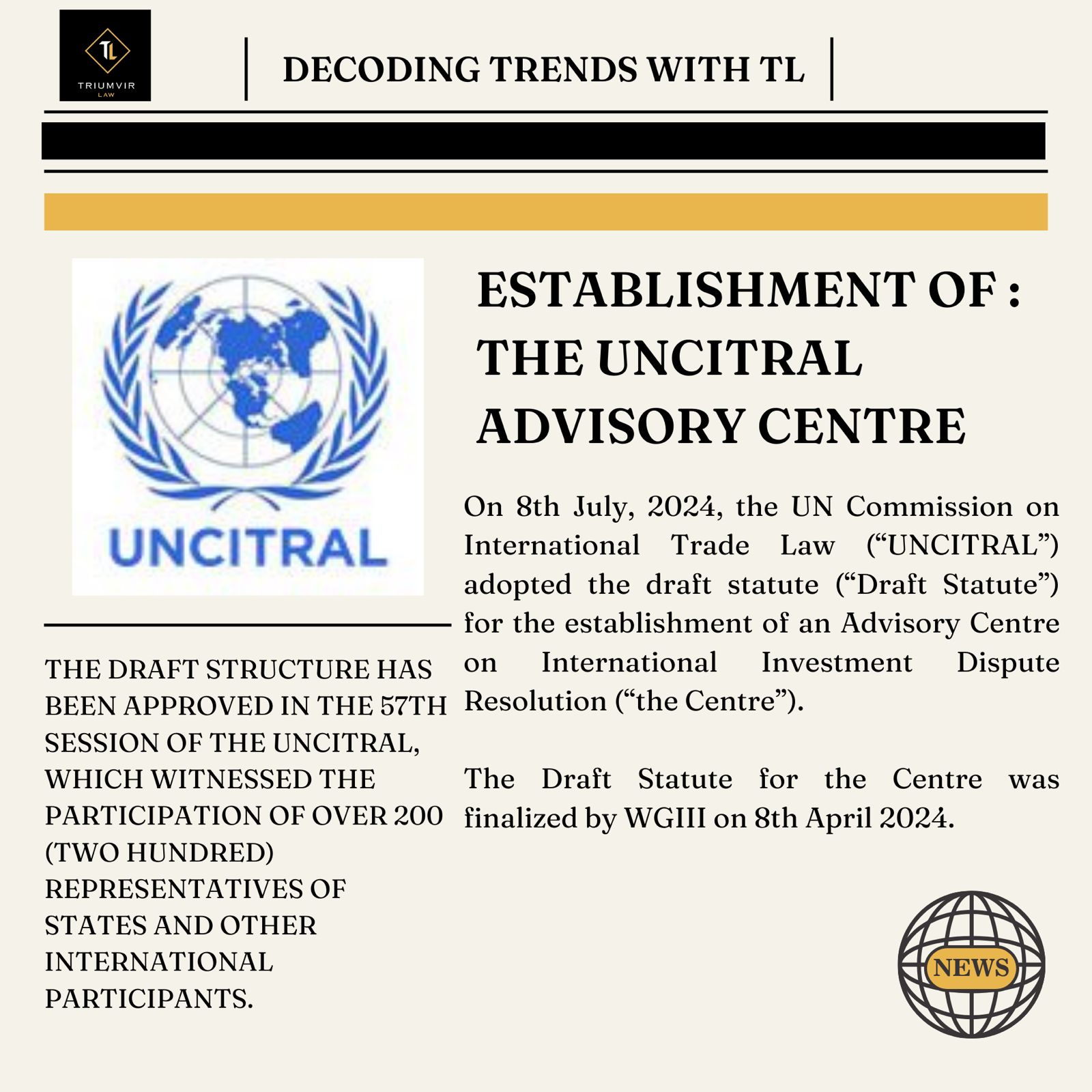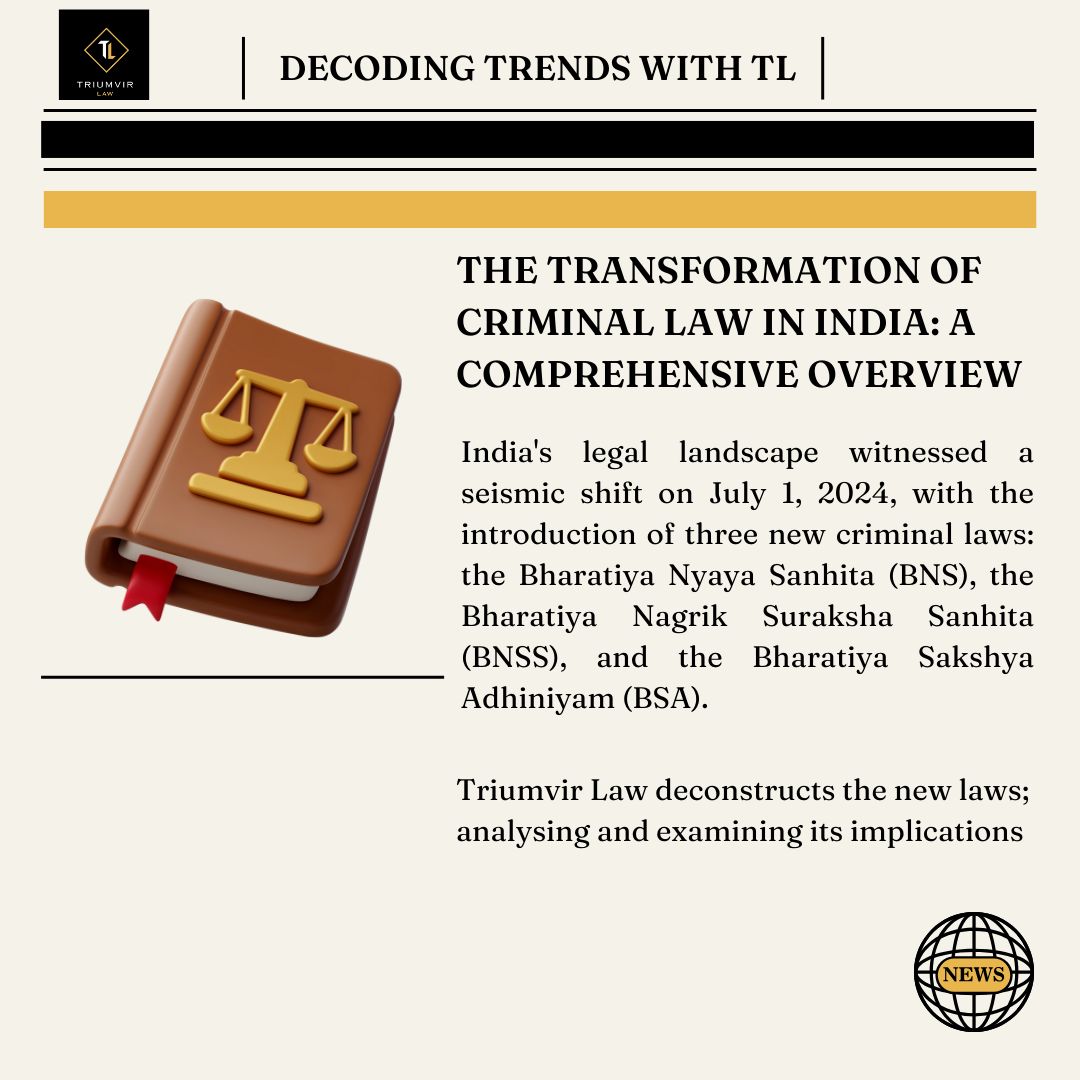
Decoding Trends With Trumvir Law

Empowering Arbitration: The Advisory Centre on International Dispute Resolution
- July 11, 2024
- Blog
- Anubhab Sarkar, Sakshi Singhania (Intern: 4th Year Student, WBNUJS)
I. Introduction
- On 8th July, 2024, the UN Commission on International Trade Law (“UNCITRAL”) adopted the draft statute (“Draft Statute”) for the establishment of an Advisory Centre on International Investment Dispute Resolution (“the Centre”). The Draft Statute for the Centre was finalized by WGIII on 8th April 2024, after lengthy discussions that started in 2019.[1]
- The Draft Structure has been approved in the 57th Session of the UNCITRAL, which witnessed the participation of over 200 (Two Hundred) representatives of States and other international participants.
II. Background
- The UNCITRAL operates through its working groups to perform the substantive preparatory work on topics within the program of the UNCITRAL.[2]
- The Draft Structure was prepared by Working Group III (“WGIII”) of the UNCITRAL, which was mandated to suggest reforms in Investor State Dispute Settlement (“ISDS”).[3] The mandate of WGIII comprised of three stages, first, identifying concerns regarding ISDS, second, considering whether reforms were desirable in the first place, and lastly, if the second question was answered in the affirmative, developing relevant solutions.[4]
III. Main Features and Purposes of the Centre
- The primary objective of the Centre is to provide training, support and assistance with respect to international investment dispute resolution. It aims to enhance the capacity of states and regional organisations in handling international investment disputes, with a special focus on the least developed countries and developing countries.[5]
- The two types of services that would be provided by the Centre in furtherance of its aim would be first technical assistance and capacity-building activities, and second, legal advice or support in specific disputes.[6]
- Technical assistance offered would include the Centre functioning as a forum for the exchange and repository of information and related resources, holding seminars and conferences, and performing similar such functions assigned to it by the Governing Committee.[7]
- The Centre is also empowered to provide a preliminary assessment of any case, assist in the selection of mediators, arbitrators or any other types of adjudicators, support in the preparation of statements, pleadings and evidence, facilitate the appointment of external legal counsel. These functions can be undertaken by the Centre only with the consent of a member state.[8]
- A key issue that witnessed divisive response was whether the Centre’s ambit should also include State to State Dispute Settlement (“SSDS”). Delegates from countries such as Switzerland, Japan, Turkey, and Russia voted against this proposition. Whereas other delegates particularly from the EU argued to draw the scope of the Centre as comprehensively as possible with a view to allow it sufficient flexibility to adapt to future trends and shift in policy.[9]
- Considering this divergence in opinion, no explicit reference is made to SSDS, and the decision to include or exclude SSDS-services was left to the Governing Committee, depending on the circumstances.[10]
IV. Membership and structure of the Centre
- The membership of the Centre is open to every state and Regional Economic Integration Organization (“REIO”). Membership of a REIO to the Centre would not ispo facto entitle the members of such REIO to benefit from the services of the Centre, unless they are member states themselves.[11]
- Member states are categorized as least developed countries, developing countries and others. The list of least developed countries features 46 countries including Afghanistan, Bangladesh, DRC, Nepal, among others.[12]
- The Centre shall consist of a three-tier body including the Governing Committee, an Executive Committee and a Secretariat headed by an Executive Director.[13] This was a step away from the two-tier structure as envisaged in the earlier drafts of the structure of the Centre.[14]
- The Governing Committee would be composed of the members’ representatives and each member would be entitled to appoint a representative each to the Governing Committee. The primary task of the Governing Committee would be to adopt rules of procedure and regulation, and periodically asses and adjust the scope and type of services of the Centre.
- The Executive Committee, comprising of two representatives from each group of countries, is required to report to the Governing Committee, and take decisions necessary to ensure the efficient and effective operation of the Centre.
- The Executive Director is entrusted with the duty to manage the day-to-day operations of the Centre and represent the Centre externally.
V. Impact of the Centre on Investor-State Dispute settlement
- The core question of whether the Centre could assist in the concerns about ISDS remains contingent on the larger position occupied by it in the wider reform process. Even though a welcoming step, the establishment of the Centre does not change the current ISDS rules or address concerns such as the high cost of proceedings. The larger aim of the Centre is to provide support for dealing with this issue.
- As discussed above, one of the key aims of the Centre is to provide capacity-building assistance to the least developed and developing states. The function of the Centre to provide such capacity developing and knowledge enhancing assistance will require persistent effort by the delegates at the international level and within their domestic states. The nature of assistance that the Centre aims to provide is such that its success would not only be predicated on the nature of reform employed by the Centre, but it also remains a test of time to see how states collaborate and implement the reforms suggested by the Centre.
- During the 47th Session in January 2024, WGIII identified a number of issues of operational nature and subsequently deferred those issues to the regulations to be adopted by the Governing Committee. These included, detailed rules on the administration of the budget and expenditures of the Centre, services to be provided as well as with regard to terms and conditions of the staff members of the Centre. Other key terms yet to be decided include the location of the Centre, the possible establishment of regional offices, contributions to be made by members.
- As established, the Centre serves as a valuable tool for states, particularly those with fewer resources or less experience in investment treaty negotiations and dispute settlement.
- The latest development thus, is a significant milestone in WGIII’s reform process, but still requires collaborative efforts from the delegates to ensure the Centre’s effective running.
[1] United Nations General Assembly, Possible reform of Investor-State Dispute Settlement (ISDS), (48th Session, 1-5 April, 2024), Document No. A/CN9/WGIII/WP238, at p.2 (“A/CN9/WGIII/WP238”).
[2] United Nations Commission on International Trade Law, Methods of Work, Available here.
[3] United Nations General Assembly, Report of the United Nations Commission on International Trade Law, (15th Session, 3-21 July, 2017), Document No. A/72/17, ¶264.
[4] United Nations General Assembly, Report of Working Group III (Investor-State Dispute Settlement Reform) on the work of its thirty-fourth session, (34th Session, 27 November-1 December, 2017), Document No. A/CN.9/930/Rev.1, ¶19.
[5] United Nations General Assembly, Report of Working Group III (Investor-State Dispute Settlement Reform) on the work of its forty-seventh session, (57th Session, 24 June-12 July, 2024), Document No.A/CN9/1161, Art.2, ¶22 (“A/CN9/1161”).
[6] United Nations General Assembly, Summary of the Intersessional meeting on investor-state dispute settlement (ISDS) reform submitted by the Government of Belgiu9m, (48th session, 1-5 April, 2024), Document No. A/CN9/WGIII/WP242, ¶29.
[7] A/CN9/1161, Article 6, ¶86.
[8] A/CN9/1161, Article 7, ¶90.
[9] United Nations General Assembly, Report of Working Group III (Investor-State Dispute Settlement Reform) on the work of its forty-sixth session, (56th Session, 24 June-12 July, 2024), Document No. A/CN9/1160, ¶¶26-28.
[10] A/CN9/WGIII/WP238, ¶10.
[11] A/CN9/1161, Article 4, ¶¶28, 29.
[12] United Nations General Assembly, Possible reform of investor-state dispute settlement (ISDS), (47th Session, 22-26 January 2024), Document No. A/CN9/WGIII/WP236, Annex I.
[13] A/CN9/WGIII/WP238, Article 5, ¶1.
[14] A/CN9/1161, Article 5, ¶42.
RECENT POST
SOCIAL SHARE
Related Post

Budget Takeaways 2024-25
Decoding Trends With Trumvir Law The Budget for FY 2024-2025, presented on July 23, 2024, aims to advance India’s growth

The Transformation of Criminal Law in India: A Comprehensive Overview
Decoding Trends With Trumvir Law India’s legal landscape witnessed a seismic shift on July 1, 2024, with the introduction of

Empowering Arbitration: The Advisory Centre on International Dispute Resolution
Decoding Trends With Trumvir Law I. Introduction On 8th July, 2024, the UN Commission on International Trade Law (“UNCITRAL”) adopted

